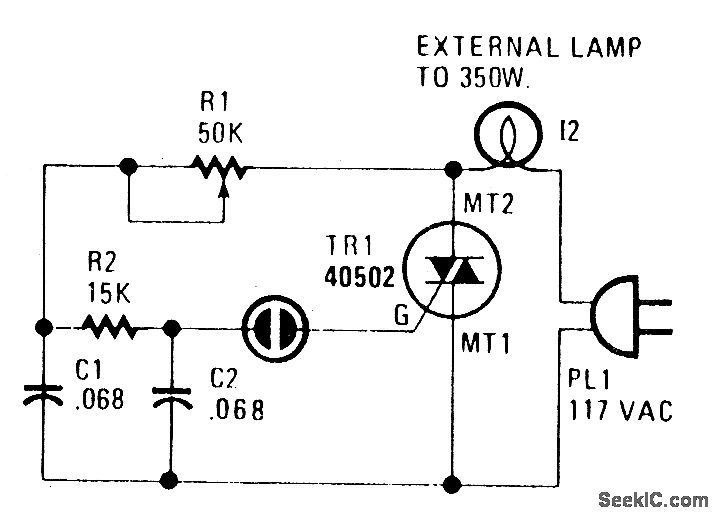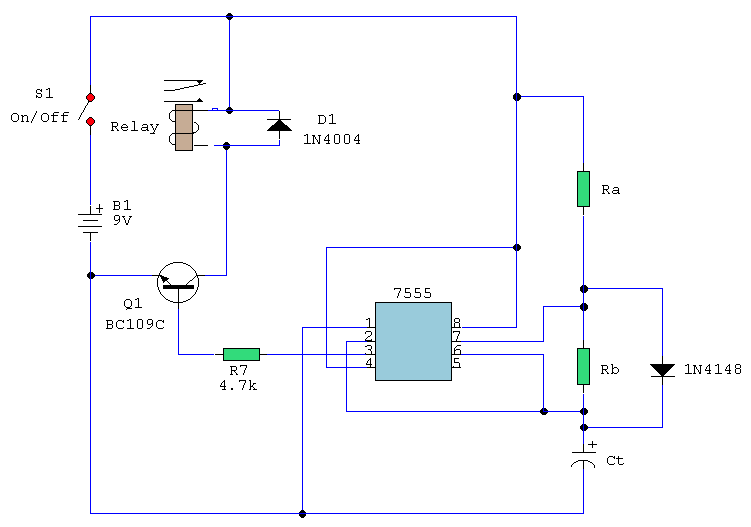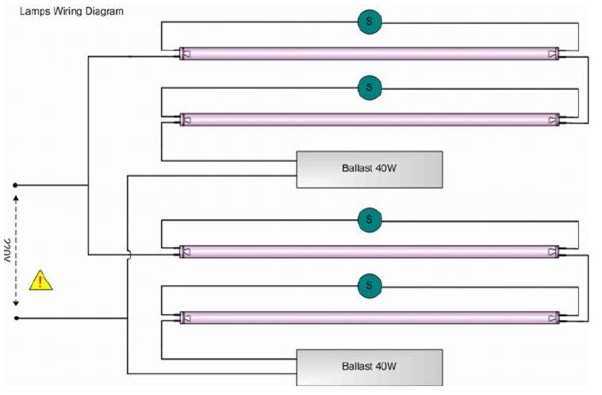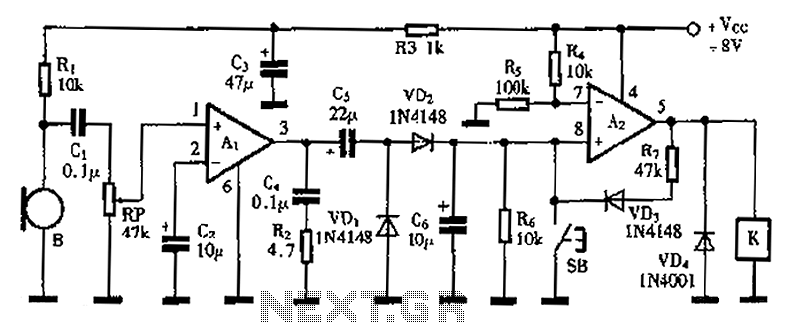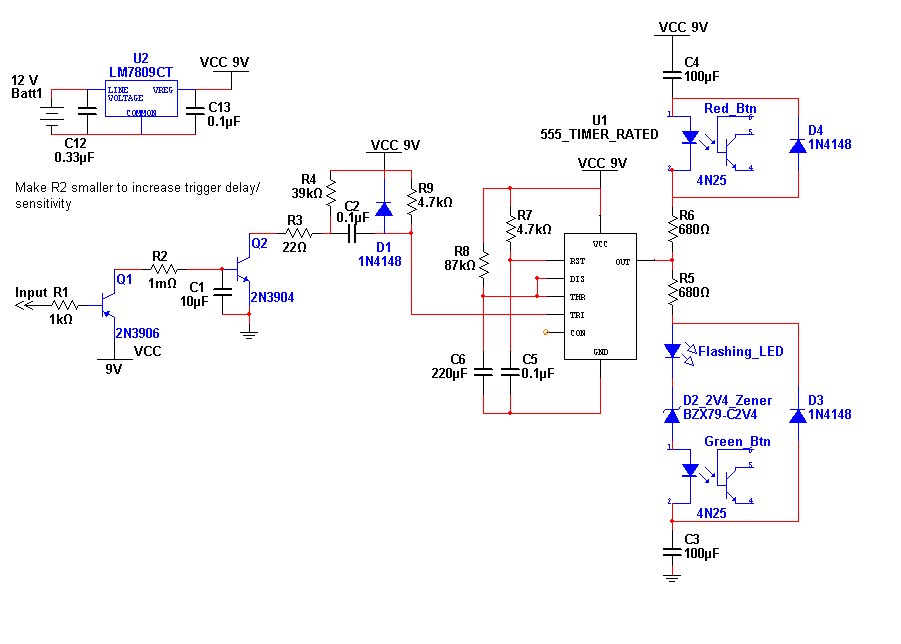
Time Delay Switch with Triac

This time delay switch circuit is designed to activate an AC load, such as lamps, after a delay of three minutes. It helps protect the load from inrush currents and transients during power-on, which can potentially harm the device. The time delay switch is directly connected to the AC lines to power the components. Resistor R1 reduces the AC voltage, and diode D1 rectifies it to provide low-voltage DC. The high-value capacitor C1 serves both as a smoothing capacitor and as the timing element; the SCR only conducts after C1 is fully charged, which takes approximately two minutes. Once C1 is fully charged, the gate of the SCR receives a firing pulse, allowing it to conduct. This, in turn, charges capacitor C2, which provides an additional one-minute delay to trigger the TRIAC via resistor R3. When the TRIAC conducts, electrical continuity is established to the AC load, turning it on. Capacitor C3 maintains the gate voltage of the TRIAC and mitigates the backlash effect. Caution is advised when handling this circuit, as it operates at mains voltage, which is lethal. It should only be constructed by an experienced individual.
The time delay switch circuit operates on the principle of controlled timing and voltage management to provide a safe and reliable method for activating AC loads. The circuit begins with the connection to the AC mains, where the resistor R1 is employed to limit the voltage to a manageable level for the subsequent components. The rectification of the AC voltage is performed by diode D1, which converts the alternating current to direct current, suitable for charging capacitors.
The capacitor C1 plays a critical role in the timing mechanism of the circuit. Its high capacitance value ensures that it takes a sufficient amount of time to charge, thus creating the desired delay before the SCR is triggered. The SCR (Silicon Controlled Rectifier) is a semiconductor device that acts as a switch, allowing current to flow only when it receives a gate pulse. The timing of this pulse is contingent upon the complete charging of C1, which is designed to take approximately two minutes.
Upon reaching the required charge, the SCR is activated, allowing current to flow to capacitor C2. This additional capacitor serves to prolong the delay before the TRIAC is triggered, providing an extra minute before the AC load is energized. Resistor R3 is crucial in this stage as it facilitates the gate triggering of the TRIAC, ensuring that the load receives power only after the complete time delay has elapsed.
The TRIAC, once triggered, allows current to pass through to the connected AC load, effectively turning it on. Capacitor C3 is included in the design to stabilize the gate voltage of the TRIAC, preventing any unintended turn-off due to voltage fluctuations or back EMF from the load.
Safety measures are paramount when working with this circuit due to its connection to high voltage AC mains. Adequate precautions must be taken to avoid electric shock, and it is strongly recommended that the assembly and testing of this circuit be performed by qualified personnel with experience in handling high-voltage electronics.This time delay switch circuit is useful to switch on an AC load such as lamps after the delay of three minutes. This protects the load from inrush current and transients at power on which may be detrimental to the device.
The time delay switch is directly connected to the AC lines to derive power to the components. Resistor R1 drops AC voltage an d D1 rectifies the same to give low volt DC. The high value capacitor C1 act as a smoothing capacitor as well as the time delay device. That is the SCR conducts only after C1 is fully charged. It takes around 2 minutes. When C1 charges fully gate of SCR gets firing pulse and it conducts. This charges C2 which also give another one minute to fire the Triac trough R3. When the triac conducts, AC load gets electrical continuity and turns on. Capacitor C3 keeps the voltage level at the gate of triac and eliminates the back lash effect. Note:Take extreme care while handling the circuit, since it is at mains lethal potential. Do not touch any points when it is connected to mains. It should be constructed only by an experienced person. 🔗 External reference
The time delay switch circuit operates on the principle of controlled timing and voltage management to provide a safe and reliable method for activating AC loads. The circuit begins with the connection to the AC mains, where the resistor R1 is employed to limit the voltage to a manageable level for the subsequent components. The rectification of the AC voltage is performed by diode D1, which converts the alternating current to direct current, suitable for charging capacitors.
The capacitor C1 plays a critical role in the timing mechanism of the circuit. Its high capacitance value ensures that it takes a sufficient amount of time to charge, thus creating the desired delay before the SCR is triggered. The SCR (Silicon Controlled Rectifier) is a semiconductor device that acts as a switch, allowing current to flow only when it receives a gate pulse. The timing of this pulse is contingent upon the complete charging of C1, which is designed to take approximately two minutes.
Upon reaching the required charge, the SCR is activated, allowing current to flow to capacitor C2. This additional capacitor serves to prolong the delay before the TRIAC is triggered, providing an extra minute before the AC load is energized. Resistor R3 is crucial in this stage as it facilitates the gate triggering of the TRIAC, ensuring that the load receives power only after the complete time delay has elapsed.
The TRIAC, once triggered, allows current to pass through to the connected AC load, effectively turning it on. Capacitor C3 is included in the design to stabilize the gate voltage of the TRIAC, preventing any unintended turn-off due to voltage fluctuations or back EMF from the load.
Safety measures are paramount when working with this circuit due to its connection to high voltage AC mains. Adequate precautions must be taken to avoid electric shock, and it is strongly recommended that the assembly and testing of this circuit be performed by qualified personnel with experience in handling high-voltage electronics.This time delay switch circuit is useful to switch on an AC load such as lamps after the delay of three minutes. This protects the load from inrush current and transients at power on which may be detrimental to the device.
The time delay switch is directly connected to the AC lines to derive power to the components. Resistor R1 drops AC voltage an d D1 rectifies the same to give low volt DC. The high value capacitor C1 act as a smoothing capacitor as well as the time delay device. That is the SCR conducts only after C1 is fully charged. It takes around 2 minutes. When C1 charges fully gate of SCR gets firing pulse and it conducts. This charges C2 which also give another one minute to fire the Triac trough R3. When the triac conducts, AC load gets electrical continuity and turns on. Capacitor C3 keeps the voltage level at the gate of triac and eliminates the back lash effect. Note:Take extreme care while handling the circuit, since it is at mains lethal potential. Do not touch any points when it is connected to mains. It should be constructed only by an experienced person. 🔗 External reference
